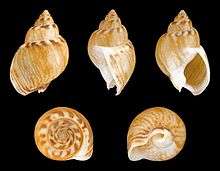Tritia mutabilis
| Tritia mutabilis | |
|---|---|
 | |
| Five views of a shell of Tritia mutabilis | |
| Scientific classification | |
| Kingdom: | Animalia |
| Phylum: | Mollusca |
| Class: | Gastropoda |
| (unranked): | clade Caenogastropoda clade Hypsogastropoda clade Neogastropoda |
| Superfamily: | Buccinoidea |
| Family: | Nassariidae |
| Subfamily: | Nassariinae |
| Genus: | Tritia |
| Species: | T. mutabilis |
| Binomial name | |
| Tritia mutabilis (Linnaeus, 1758) | |
| Synonyms[1] | |
| |
Tritia mutabilis, common name : the mutable nassa, is a species of sea snail, a marine gastropod mollusk in the family Nassariidae, the nassa mud snails or dog whelks.[2]
Description
The size of an adult shell varies between 14 mm and 30 mm.
The smooth shell is ovate, conical, and slightly ventricose. The spire is composed of seven whorls, rounded and swollen at the upper part, especially the lowest, which is larger than all the others united. The three upper whorls are finely plaited. The body whorl has a few fine, transverse striae near the base. The aperture is white and ovate, pretty strongly emarginated, and oblique at the base. The depth of the cavity is chestnut-colored. The thin outer lip is white and very finely striated internally. The inner lip is thin, white and shining and partially covers the body of the shell. The columella arcuated and terminates at the base by a sharp, and slightly projecting keel. The exterior of the shell is red or fawn-colored, ornamented with an articulated band of white and violet upon the upper edge of the whorls, with waved longitudinal yellow or red spots, the tint of which is sometimes very deep, and often very pale.
This shell, which is very common, presents somewhat remarkable varieties of color. Sometimes its ground is red ; and white, undulated, very crowded flames, or brown and distant longitudinal lines ornament it from one end to the other. At other times it is whitish, which happens when it has been a long time exposed to the light ; and in this case transverse striae are perceptible on its surface. But the articulated band about the suture always appears in each of these varieties. [3]
Distribution
This species occurs in the Mediterranean Sea, the Black Sea, in the Atlantic Ocean off Mauritania and West Africa.
References
- ↑ CLEMAM: Nassarius mutabilis
- ↑ Marshall, B. (2016). Tritia mutabilis (Linnaeus, 1758). Accessed through: World Register of Marine Species at http://www.marinespecies.org/aphia.php?p=taxdetails&id=876840 on 2016-05-18
- ↑ Kiener (1840). General species and iconography of recent shells : comprising the Massena Museum, the collection of Lamarck, the collection of the Museum of Natural History, and the recent discoveries of travellers; Boston :W.D. Ticknor,1837 (described as Buccinum mutabile)
- Bernard, P.A. (Ed.) (1984). Coquillages du Gabon [Shells of Gabon]. Pierre A. Bernard: Libreville, Gabon. 140, 75 plates pp.
- Cernohorsky W. O. (1984). Systematics of the family Nassariidae (Mollusca: Gastropoda). Bulletin of the Auckland Institute and Museum 14: 1-356
- Gofas, S.; Le Renard, J.; Bouchet, P. (2001). Mollusca, in: Costello, M.J. et al. (Ed.) (2001). European register of marine species: a check-list of the marine species in Europe and a bibliography of guides to their identification. Collection Patrimoines Naturels, 50: pp. 180-213
External links
| Wikimedia Commons has media related to Tritia mutabilis. |